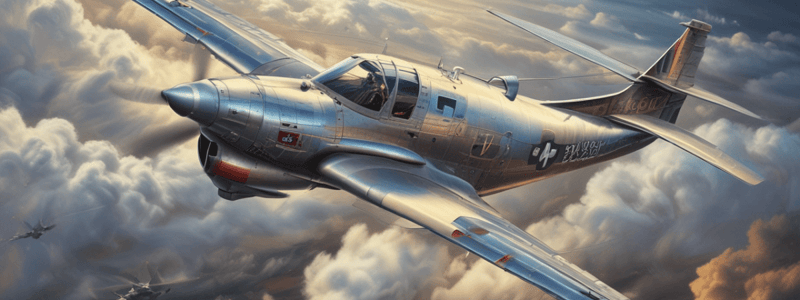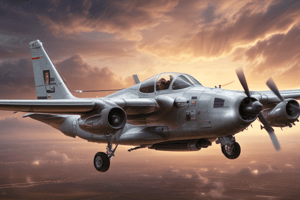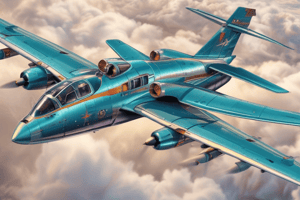Podcast
Questions and Answers
What is the primary advantage of fixed-pitch propellers?
What is the primary advantage of fixed-pitch propellers?
- Optimal performance across a range of speeds and altitudes
- Flexibility in adjusting to different flight regimes
- Ability to maintain a constant engine speed
- Simpler design and lower cost (correct)
What is the purpose of the governor in a propeller system?
What is the purpose of the governor in a propeller system?
- To hold the blades in place
- To control the air conditioning system
- To maintain a constant engine speed
- To regulate the blade pitch (correct)
What is the primary function of the environmental control system (ECS)?
What is the primary function of the environmental control system (ECS)?
- To maintain a constant propeller pitch
- To prevent icing on critical surfaces
- To regulate cabin pressure and air quality (correct)
- To control the engine speed
What system provides supplemental oxygen to passengers and crew in case of cabin depressurization?
What system provides supplemental oxygen to passengers and crew in case of cabin depressurization?
What is the purpose of the anti-ice and deice systems?
What is the purpose of the anti-ice and deice systems?
What is the primary advantage of variable-pitch propellers?
What is the primary advantage of variable-pitch propellers?
What is the purpose of the hub in a propeller system?
What is the purpose of the hub in a propeller system?
What system maintains cabin pressure at a safe and comfortable level?
What system maintains cabin pressure at a safe and comfortable level?
What is the primary purpose of the ventilation system?
What is the primary purpose of the ventilation system?
What is the primary function of the propeller system?
What is the primary function of the propeller system?
Fixed-pitch propellers are more complex in design than variable-pitch propellers.
Fixed-pitch propellers are more complex in design than variable-pitch propellers.
The pilot can adjust the blade pitch of a fixed-pitch propeller during flight.
The pilot can adjust the blade pitch of a fixed-pitch propeller during flight.
The governor is responsible for regulating the engine speed of an aircraft.
The governor is responsible for regulating the engine speed of an aircraft.
The air conditioning system is responsible for maintaining cabin pressure.
The air conditioning system is responsible for maintaining cabin pressure.
The ventilation system is responsible for providing supplemental oxygen to passengers and crew.
The ventilation system is responsible for providing supplemental oxygen to passengers and crew.
The propeller system includes the engine, hub, and blades.
The propeller system includes the engine, hub, and blades.
Environmental control systems are only necessary for high-altitude flights.
Environmental control systems are only necessary for high-altitude flights.
The anti-ice and deice systems are only used on the wings of an aircraft.
The anti-ice and deice systems are only used on the wings of an aircraft.
The hub is responsible for regulating the blade pitch of a propeller.
The hub is responsible for regulating the blade pitch of a propeller.
Aircraft engines, propellers, and environmental control systems operate independently of each other.
Aircraft engines, propellers, and environmental control systems operate independently of each other.
How do fixed-pitch propellers differ from variable-pitch propellers in terms of design and functionality?
How do fixed-pitch propellers differ from variable-pitch propellers in terms of design and functionality?
What are the primary components of the propeller system, and how do they work together?
What are the primary components of the propeller system, and how do they work together?
What are the key functions of the environmental control system (ECS) in an aircraft?
What are the key functions of the environmental control system (ECS) in an aircraft?
How do the engine, propeller, and environmental control systems interact to ensure efficient aircraft operation?
How do the engine, propeller, and environmental control systems interact to ensure efficient aircraft operation?
What are the consequences of not having an effective environmental control system (ECS) in an aircraft?
What are the consequences of not having an effective environmental control system (ECS) in an aircraft?
How do variable-pitch propellers adapt to changing flight regimes, and what are the benefits of this adaptability?
How do variable-pitch propellers adapt to changing flight regimes, and what are the benefits of this adaptability?
What are the primary benefits of using a governor in a propeller system?
What are the primary benefits of using a governor in a propeller system?
How do the air conditioning and ventilation systems contribute to the overall environmental control system (ECS) in an aircraft?
How do the air conditioning and ventilation systems contribute to the overall environmental control system (ECS) in an aircraft?
What are the consequences of not having an effective anti-ice and deice system in an aircraft?
What are the consequences of not having an effective anti-ice and deice system in an aircraft?
How does the environmental control system (ECS) impact the overall safety and comfort of passengers and crew in an aircraft?
How does the environmental control system (ECS) impact the overall safety and comfort of passengers and crew in an aircraft?
Flashcards are hidden until you start studying
Study Notes
Fundamentals of Aircraft Systems for Aspiring Pilots
- Aircraft systems are the lifeblood of any aircraft, providing safe, efficient, and effective operation.
- These systems can be broadly classified into primary categories:
- Engine systems
- Fuel systems
- Electrical systems
- Hydraulic systems
- Avionics systems
- Environmental control systems
Engine Systems
- Engine systems provide the thrust necessary for flight.
- Types of aircraft engines:
- Reciprocating engines (piston engines)
- Turbine engines (jet engines and turboprops)
- Reciprocating engines:
- Found in smaller aircraft
- Function similarly to car engines
- Convert chemical energy from fuel into mechanical energy
- Turbine engines:
- Provide high levels of thrust and efficiency at high altitudes and speeds
- Operate on the principle of air intake, compression, combustion, and exhaust
- Components: fuel injectors, spark plugs, combustion chambers, turbine blades, and exhaust systems
Propeller Systems
- Propeller systems translate the engine's rotational power into forward motion (thrust).
- Propeller designs:
- Fixed-pitch propellers
- Variable-pitch propellers
- Fixed-pitch propellers:
- Simpler in design
- Easier to maintain
- More cost-effective
- Offer less flexibility in adjusting to different flight regimes
- Variable-pitch propellers:
- Allow for optimal performance across a range of speeds and altitudes
- Components: hub, governor, and blade design
Environmental Control Systems
- Environmental control systems (ECS) regulate cabin pressure, temperature, and air quality.
- Components:
- Pressurization system
- Air conditioning system
- Ventilation system
- Oxygen systems
- Anti-ice and deice systems
- ECS ensures a safe and comfortable cabin environment, especially at high altitudes.
Fundamentals of Aircraft Systems
- Aircraft systems are the lifeblood of any aircraft and can be broadly classified into primary categories.
- The primary categories of aircraft systems include:
- Engine systems
- Fuel systems
- Electrical systems
- Hydraulic systems
- Avionics systems
- Environmental control systems
Engine Systems
- The engine is the heart of the aircraft, providing the thrust necessary for flight.
- There are two main categories of aircraft engines:
- Reciprocating engines (piston engines)
- Turbine engines (jet engines and turboprops)
- Reciprocating engines:
- Function similarly to car engines
- Commonly found in smaller, general aviation aircraft
- Convert chemical energy from fuel into mechanical energy
- Turbine engines:
- Operate on the principle of air intake, compression, combustion, and exhaust
- Provide high levels of thrust and efficiency at high altitudes and speeds
- Used in a wide range of aircraft, from regional airliners to large military transport planes
Propeller Systems
- The propeller is a critical component that translates the engine's rotational power into forward motion, known as thrust.
- Propellers come in various designs, including:
- Fixed-pitch propellers
- Variable-pitch propellers
- Fixed-pitch propellers:
- Have blades that are set at a constant angle
- Simpler in design, easier to maintain, and more cost-effective
- Offer less flexibility in adjusting to different flight regimes
- Variable-pitch propellers:
- Have blades whose pitch can be altered by the pilot or an automatic control system
- Allow for optimal performance across a range of speeds and altitudes
Environmental Control Systems
- Environmental control systems (ECS) are essential for maintaining a safe and comfortable cabin environment.
- ECS regulates:
- Cabin pressure
- Temperature
- Air quality
- ECS includes:
- Pressurization system
- Air conditioning system
- Ventilation system
- Oxygen systems
- Anti-ice and deice systems
Fundamentals of Aircraft Systems
- Aircraft systems are intricate networks of components that ensure safe and efficient operation of an aircraft.
- Understanding these systems is crucial for pilots and aviation professionals.
Primary Systems of an Aircraft
- Engine System: provides the thrust necessary for flight.
- Reciprocating engines (piston engines): commonly found in smaller, general aviation aircraft.
- Turbine engines: used in a wide range of aircraft, from regional airliners to large military transport planes.
- Engine components: fuel injectors, spark plugs, combustion chambers, turbine blades, and exhaust systems.
- Propeller System: translates the engine's rotational power into forward motion (thrust).
- Propeller designs: fixed-pitch and variable-pitch, each suited for different types of flight conditions and performance requirements.
- Fixed-pitch propellers: simpler in design, easier to maintain, and more cost-effective.
- Variable-pitch propellers: have blades whose pitch can be altered by the pilot or an automatic control system.
- Environmental Control Systems (ECS): maintains a safe and comfortable cabin environment.
- ECS components: pressurization system, air conditioning system, ventilation system, oxygen systems, and anti-ice and deice systems.
Engine System Components
- Fuel injectors: inject fuel into the combustion chamber.
- Spark plugs: ignite the air-fuel mixture in piston engines.
- Combustion chambers: where fuel is ignited to produce high-pressure and high-velocity gases.
- Turbine blades: convert the energy of the hot gases into mechanical energy.
- Exhaust systems: expel the hot gases out of the engine.
Propeller System Components
- Hub: holds the blades in place and connects the propeller to the engine.
- Governor: regulates the blade pitch to maintain a constant engine speed despite changing aerodynamic loads.
Environmental Control Systems (ECS) Components
- Pressurization system: maintains cabin pressure at a safe and comfortable level.
- Air conditioning system: controls temperature and humidity.
- Ventilation system: ensures a continuous supply of fresh air.
- Oxygen systems: provide supplemental oxygen to passengers and crew in case of cabin depressurization.
- Anti-ice and deice systems: prevent the accumulation of ice on critical surfaces such as wings, propellers, and sensors.
Studying That Suits You
Use AI to generate personalized quizzes and flashcards to suit your learning preferences.




